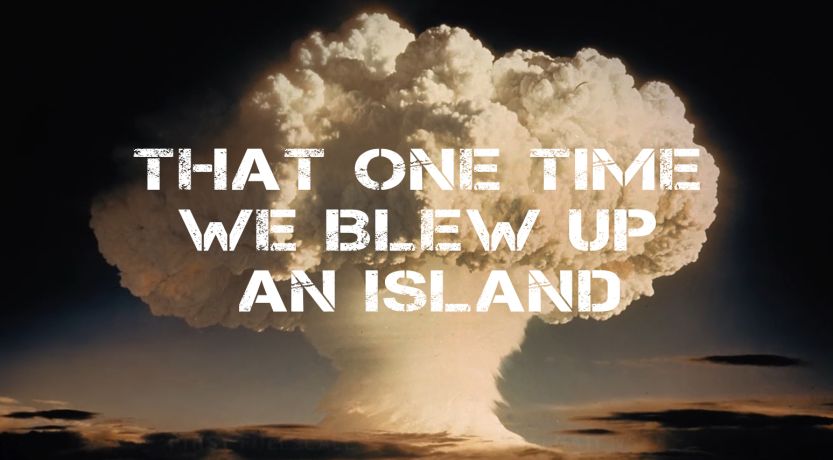That One Time We Blew Up an Island
Sixty-five years ago today, the world powers were in a frenzy of nuclear research and development in the hopes of ensuring “peace and security.” Did it work?

On Saturday, Nov. 1, 1952, at 7:14 a.m., Elugelab was an island in the Enewetak Atoll.
At 7:16 a.m., it wasn’t.
This is because at 7:15 a.m., Elugelab was enveloped in a blinding flash of light and subjected to a 10.4 megaton explosion—a blast over 600 times more powerful than the atomic bomb that decimated Hiroshima during World War II.
At the epicenter of that explosion was Mike. Mike was a thermonuclear bomb—the first in human history. It was an attempt to enhance the explosive yield of nuclear weapons using the power of fusion.
It worked.
Within moments, Elugelab was transformed into a smoking crater over a mile wide and deep enough to contain a 15-story building. Today you can use Bing or Google Maps to take a look at the gaping hole where Elugelab used to be.
Bigger and badder
In 1950 then-President Harry S. Truman explained, “It is part of my responsibility as Commander in Chief of the Armed Forces to see to it that our country is able to defend itself against any possible aggressor. Accordingly, I have directed the Atomic Energy Commission to continue its work on all forms of atomic weapons, including the so-called hydrogen or superbomb. Like all other work in the field of atomic weapons, it is being and will be carried forward on a basis consistent with the overall objectives of our program for peace and security.”
Mike was that superbomb—but it wasn’t the only superbomb. Beginning in 1942, the United States spent half a century building and testing over 1,100 nuclear devices of all shapes and sizes. In fact, not even two years after Mike blew Elugelab off the map, the detonation of Castle Bravo blew another, deeper crater into the Bikini Atoll.
President Theodore Roosevelt famously spoke about speaking softly and carrying a big stick—President Truman was authorizing the production of sticks powerful enough to alter geography.
Not that the rest of the world was content to sit and watch while the United States stockpiled weapons of mass destruction. Other nations—especially the Soviet Union—began producing thermonuclear weapons of their own. During the United States’ half-century of testing, the U.S.S.R., the United Kingdom, China and France all detonated their own share of hydrogen bombs—ostensibly as tests, but also as reminders to the rest of the world:
“We have big sticks too.”
A post-Mike world
Which brings us to today.
Sixty-five years after our first detonation of the superbomb, are we in a better place?
With many world powers in possession of nuclear weapons and many more looking to join those ranks, are we more secure? Is our peace more unshakable than ever?
The problem with having the biggest stick in the room is that it only works until someone else comes along with a bigger, better, faster one. Positions of power are always shifting, shifting, shifting as new technologies and new developments surface. It’s a mad scramble to stay on top—and even then, it wouldn’t take much more than a single stray missile to send the world spiraling into chaos.
The problem with having the biggest stick in the room is that it only works until someone else comes along with a bigger, better, faster one.
Think about it—if Mike was powerful enough to blow an island off the map 65 years ago, what kind of damage could an entire arsenal of modern intercontinental ballistic missiles and nuclear warheads do? It was all the way back in 1961 when the Soviets detonated the record-shattering Tsar Bomba, which had a 50-megaton yield—enough to level everything in a 35-mile radius.
(If that sounds bad, consider the fact that it was originally designed to yield 100 megatons, but engineers had to ratchet it down for a variety of reasons—not least of all because the crew of the plane deploying it would probably have been vaporized in the explosion. And that was 1961!)
As the old Albert Einstein quote goes, “I know not with what weapons World War III will be fought, but World War IV will be fought with sticks and stones.”
Following a path
Nuclear weapons are capable of unbelievable destruction, it’s true—but they can’t guarantee our safety. They can’t protect us. They’re only a deterrent until someone builds a stronger, more fearsome weapon—and unless someone pulls the trigger, our weapons will only get more and more terrifying, more and more destructive, more and more unstoppable.
That’s not what safety looks like. It’s certainly not what peace looks like. Those are the symptoms of a world perpetually on the brink of self-destructing.
So what’s the solution?
The Bible talks about “the way of peace,” specifically in terms of those who don’t know it: “There is no justice in their ways; they have made themselves crooked paths; whoever takes that way shall not know peace” (Isaiah 59:8). It also warns, “There is a way that seems right to a man, but its end is the way of death” (Proverbs 14:12).
Two paths—the way of peace and the way of death. The first one coexists with justice and doesn’t always make intuitive sense, while the second one often seems like the right way to go but ultimately ends in disaster.
Which category do you think stockpiling world-ending weapons as a safety measure falls under?
The Highway of Holiness
For a long time, the world has been trying to find the way to peace and security without God.
It isn’t working.
Once we finally prove to ourselves that our way—the “way that seems right to a man”—isn’t going to work, God will intervene.
It’s never going to work. Six thousand years of recorded human history stand as a grim witness to the fact that no nation or people has ever found the secret to permanent, lasting peace in this life. Nations rise and fall, wars begin and end, and nothing … ever … changes.
But things will change.
God will only allow things to continue like this for so long. Eventually, He will step in and take the reins back before we completely self-destruct. Once we finally prove to ourselves that our way—the “way that seems right to a man”—isn’t going to work, God will intervene. Isaiah 35:8-10 shows that He’ll establish His government and, over time, show the world what true peace looks like:
A highway shall be there, and a road,
And it shall be called the Highway of Holiness. …
Whoever walks the road, although a fool,
Shall not go astray. …
The redeemed shall walk there,
And the ransomed of the LORD shall return,
And come to Zion with singing,
With everlasting joy on their heads.
They shall obtain joy and gladness,
And sorrow and sighing shall flee away.
A better way
Today, the world isn’t walking on the Highway of Holiness. Sorrow and sighing are still hanging around. We’re still hoping peace and safety comes from having the biggest sticks, but it doesn’t work that way.
What we need is a better way to look at things—and that way is coming. We will one day live in a world where bombs like Mike and Castle Bravo and the Tsar Bomba will be obsolete—not because someone built a better weapon, but because the world adopted a better way of life.
In the meantime, peace is something we can—and should—have in our own lives. Read our article “Fruit of the Spirit: Peace” to see what the Bible says about finding peace in a troubled world.
Date Posted: November 1, 2017



